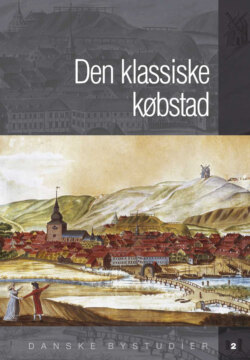Читать книгу Den klassiske kobstad - Группа авторов - Страница 17
На сайте Литреса книга снята с продажи.
Summary Characterization and Historiography of the Early Modern Danish Market Towns
ОглавлениеBy Søren Bitsch Christensen, PhD, Associate Professor, Director of the Danish Centre for Urban History
The main trend of Danish urban history in the Early Modern period was one of weak or stagnated urbanization within an evolving primate city system centred on the capital of Copenhagen. The primacy is measured by, among other things, the payment of town taxes. From 1596 to 1621 Copenhagen paid almost the same amount of tax as all the other towns in Zealand put together. By the middle of the 18th century, however, the city paid five times more and in 1864 ten times more. Within all regions the economic strength of towns could change, but the relative distribution between regions was generally stable.
From the beginning of Absolute Monarchy in 1660 until the very earliest stages of industrialization, around 1840, the urbanization ratio was approximately twenty per cent. The urban population began to grow at a faster rate, though, from the last decades of the 18th century, and from around 1800 even faster than the rural population. Hence, the urban standstill ended. The article discusses reasons for this development, and it is noted that at various points Denmark contrasted the general European and even Nordic trends. Only a few new towns were actually founded, and apart from a handful of minor coastal towns in Northern Jutland a geographical expansion of the urban system did not occur. The new towns that began to develop were primarily for the purpose of fulfilling the new centrality functions of state administration or defence. In general, market conditions did not favour new towns since the prevailing economy of the typical market town was based on the sale of agricultural products to Copenhagen and Norway. The technological level was more or less unchanged and proto industry was very sparse. The early phase of renewed urban growth in the late 18th century was to some extent tied to expanding maritime centres and it was only from around 1800 that growth began to take place, due to classical service centre functions which were the result of increasing exports of grain to Northern Europe. The state did not formulate an urban policy to support this development, but the towns were – rightly – believed to prosper from agricultural reforms after 1780. However, important reforms of the harbour and road infrastructure were launched in the 1790s.
New research has shed light on these trends, but many aspects have still not been researched thoroughly enough. Research into urban segregation has, however, been more impressive. A number of results support Gideon Sjoberg’s classical vision of the Early Modern city. With regard to another main theme – urban cultural and political studies – a few, but important, results are discussed. It seems that cultural and political urbanism both went along with and fought the dominating influence of Absolutism. Politically, administratively, and culturally, urban autonomy suffered some serious setbacks. Examples are given: town musicians, for instance, became royal servants and the old voluntary civic guards were replaced in 1801 by a new state military system. Clubs and societies were, likewise, of a patriotic nature. On the other hand, literary preferences were individualistic and rationalistic, and the craft guilds and their old culture were never really defeated. Eventually, from 1857-1862, the market-town system was dramatically changed as trade and craft activities were liberalized and the guilds abolished. In 1837, part of their former self-rule was given back to the towns, and these forces – combined with the growth of industrialization – marked the end of the classical market-town system.
